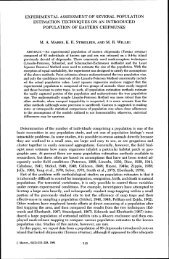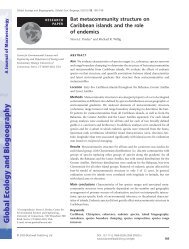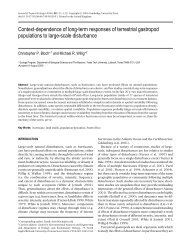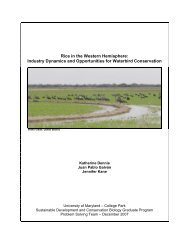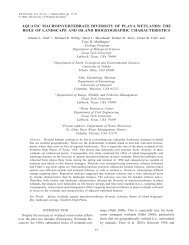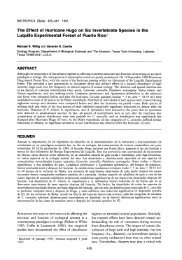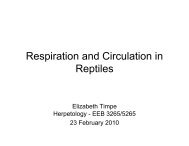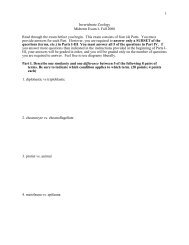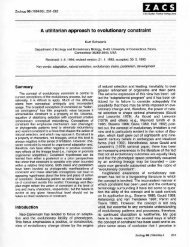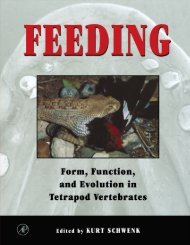Tadpole shrimp structure macroinvertebrate communities in playa ...
Tadpole shrimp structure macroinvertebrate communities in playa ...
Tadpole shrimp structure macroinvertebrate communities in playa ...
Create successful ePaper yourself
Turn your PDF publications into a flip-book with our unique Google optimized e-Paper software.
trials, tadpole <strong>shrimp</strong> were removed at this time,<br />
approximately 3–5 days after their emergence. The<br />
orig<strong>in</strong>al water and all other <strong>in</strong>vertebrates were<br />
returned to each aquarium. Control trials were<br />
treated <strong>in</strong> the same manner, but all <strong>in</strong>vertebrates,<br />
<strong>in</strong>clud<strong>in</strong>g tadpole <strong>shrimp</strong>, were returned to each<br />
aquarium. Because smaller tadpole <strong>shrimp</strong> may be<br />
<strong>in</strong>conspicuous and new <strong>in</strong>dividuals may enclose<br />
dur<strong>in</strong>g the second week, the treatment for many<br />
microcosms was a reduction <strong>in</strong> tadpole <strong>shrimp</strong><br />
densities rather than their elim<strong>in</strong>ation, per se. After<br />
two weeks, all microcosms were sampled destructively<br />
by siphon<strong>in</strong>g water through a D-net and<br />
collect<strong>in</strong>g all <strong>in</strong>vertebrates. Most <strong>in</strong>vertebrates<br />
were classified to familial level.<br />
Statistical analyses<br />
Taxonomic richness, evenness, diversity, dom<strong>in</strong>ance,<br />
and total <strong>in</strong>vertebrate abundance were calculated<br />
for each <strong>playa</strong> microcosm <strong>in</strong> each of the four<br />
trials, and compared to determ<strong>in</strong>e the effects of<br />
tadpole <strong>shrimp</strong> on <strong>in</strong>vertebrate <strong>communities</strong>. <strong>Tadpole</strong><br />
<strong>shrimp</strong> were excluded from calculations.<br />
Evenness or equitability (E) was estimated as<br />
E ¼ H 0 /log S, where H’ is taxonomic diversity and S<br />
is taxonomic richness (Peilou, 1969). We calculated<br />
diversity (H 0 ) by the Shannon–We<strong>in</strong>er <strong>in</strong>dex as H 0 =<br />
) P p i (log pi), where pi is the ratio of <strong>in</strong>dividuals <strong>in</strong><br />
taxonomic group i to the total number of <strong>in</strong>dividuals<br />
<strong>in</strong> all taxonomic groups (Magurran, 1988). Dom<strong>in</strong>ance<br />
(D) was calculated as the Berger–Parker<br />
<strong>in</strong>dex: D ¼ N max/N,whereN max is the density of the<br />
most abundant taxonomic group, and N is total<br />
<strong>in</strong>vertebrate abundance (Magurran, 1988).<br />
The effects of tadpole <strong>shrimp</strong> reduction on<br />
taxonomic richness, evenness, diversity, dom<strong>in</strong>ance,<br />
and total <strong>in</strong>vertebrate abundance were<br />
tested with partly nested multivariate analysis of<br />
variance (MANOVA-PROC GLM, SAS Institute,<br />
1990) to assess differences between treatments<br />
(reduced tadpole <strong>shrimp</strong> vs. controls), between<br />
trials with<strong>in</strong> each treatment, and among <strong>playa</strong>s,<br />
treated as a random effect. To determ<strong>in</strong>e if treatment<br />
effects were consistent among <strong>playa</strong>s, we also<br />
exam<strong>in</strong>ed the <strong>in</strong>teraction between <strong>playa</strong> and<br />
treatment. Significant MANOVA effects were<br />
<strong>in</strong>terpreted by exam<strong>in</strong><strong>in</strong>g univariate tests (ANO-<br />
VA) for each of the five community characteristics,<br />
which have <strong>in</strong>dividual biological <strong>in</strong>terest (Qu<strong>in</strong>n &<br />
141<br />
Keough, 2002). In order to homogenize variances<br />
and adhere to assumptions of normality, total<br />
abundance was square-root transformed (Sokal &<br />
Rohlf, 1995). We treated the total number of<br />
tadpole <strong>shrimp</strong> present <strong>in</strong> each microcosm dur<strong>in</strong>g<br />
the first week of the experiment, i.e., prior to<br />
experimental reduction, as a covariate. Covariate<br />
effects were not significant, however, and subsequently<br />
dropped from analyses. In both treatment<br />
and control trials, some microcosms by chance had<br />
no tadpole <strong>shrimp</strong>. These microcosms were not<br />
excluded from analyses because we feel they contribute<br />
<strong>in</strong>formation about natural variability <strong>in</strong><br />
tadpole <strong>shrimp</strong> density among <strong>playa</strong>s.<br />
We also exam<strong>in</strong>ed the effects of tadpole <strong>shrimp</strong><br />
on community composition by exam<strong>in</strong><strong>in</strong>g the<br />
abundances of each taxonomic group, exclud<strong>in</strong>g<br />
tadpole <strong>shrimp</strong>. We used Pr<strong>in</strong>cipal Components<br />
Analysis (PCA-PROC FACTOR, SAS Institute,<br />
1990) to extract <strong>in</strong>dependent pr<strong>in</strong>cipal components<br />
represent<strong>in</strong>g major taxonomic compositions. In<br />
addition to PCA on non-transformed taxon<br />
abundances, two additional PCAs were run to<br />
address potential distortion due to rare taxa<br />
(Clarke & Warwick, 1994). First, taxon abundances<br />
were double square-root transformed to<br />
downweight abundances of abundant taxa. Second,<br />
because rare taxa can have a strong effect on<br />
PCA, analyses were run with only the seven most<br />
abundant (>100 <strong>in</strong>dividuals) taxa. In each analysis,<br />
pr<strong>in</strong>cipal components with eigenvalues<br />
greater than 1.00 were used (Hatcher & Stepanski,<br />
1994) <strong>in</strong> subsequent analyses. The effect of tadpole<br />
<strong>shrimp</strong> on community composition was then tested<br />
us<strong>in</strong>g partly nested multivariate analysis of variance<br />
(MANOVA-PROC GLM, SAS Institute,<br />
1990) to exam<strong>in</strong>e responses of reta<strong>in</strong>ed pr<strong>in</strong>cipal<br />
components to treatments (reduced tadpole<br />
<strong>shrimp</strong> vs. controls), between trials with<strong>in</strong> each<br />
treatment, and among <strong>playa</strong>s, treated as a random<br />
effect. We also exam<strong>in</strong>ed the <strong>in</strong>teraction between<br />
<strong>playa</strong> and treatment. Significant MANOVA effects<br />
were <strong>in</strong>terpreted us<strong>in</strong>g standardized canonical<br />
coefficients (Qu<strong>in</strong>n & Keough, 2002) which account<br />
for the simultaneous responses of taxa<br />
with<strong>in</strong> the community by quantify<strong>in</strong>g the magnitude<br />
of the contributions of <strong>in</strong>dividual pr<strong>in</strong>cipal<br />
components <strong>in</strong> produc<strong>in</strong>g significant multivariate<br />
differences. Aga<strong>in</strong> tadpole <strong>shrimp</strong> density dur<strong>in</strong>g<br />
the first week was treated as a covariate. Covariate



